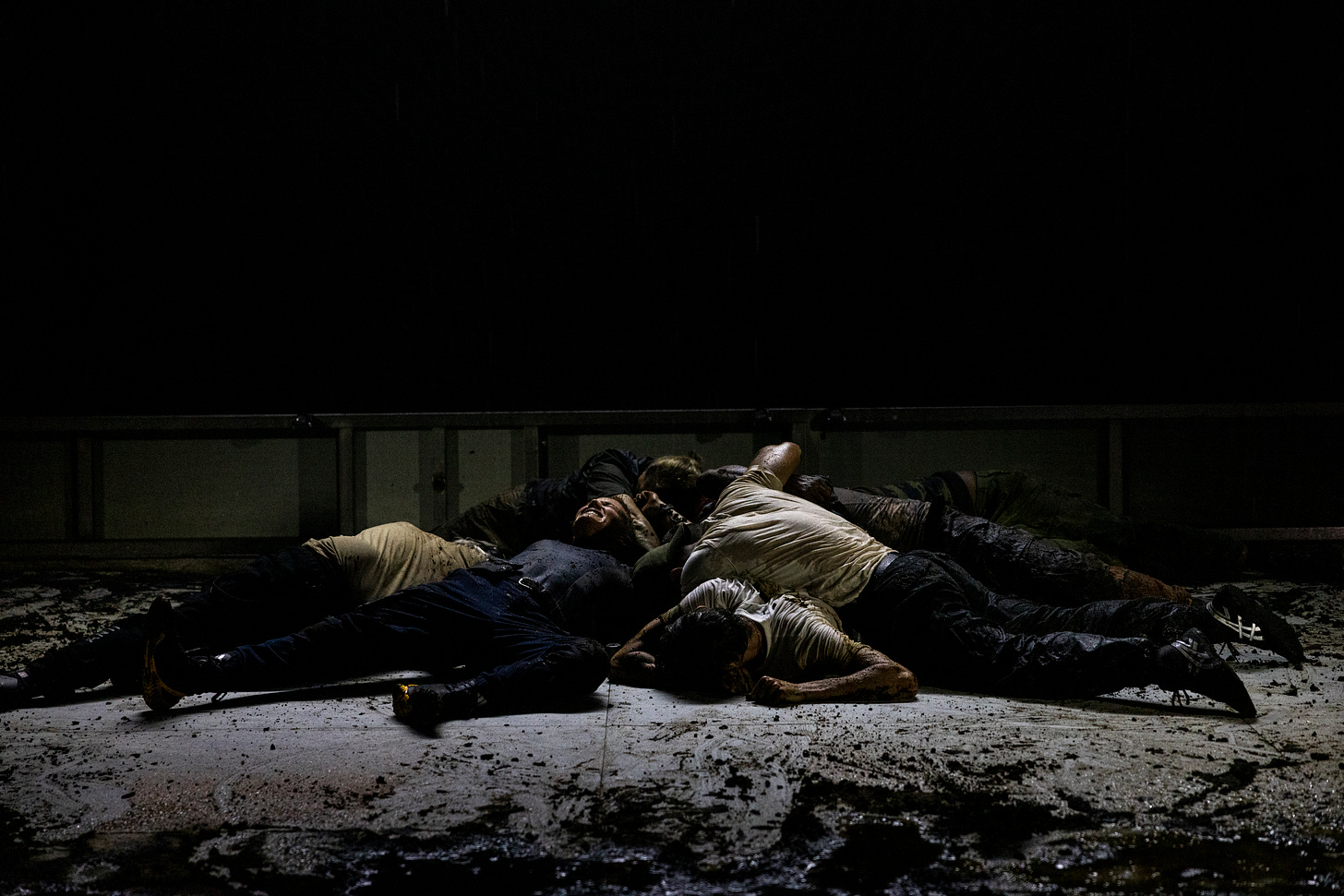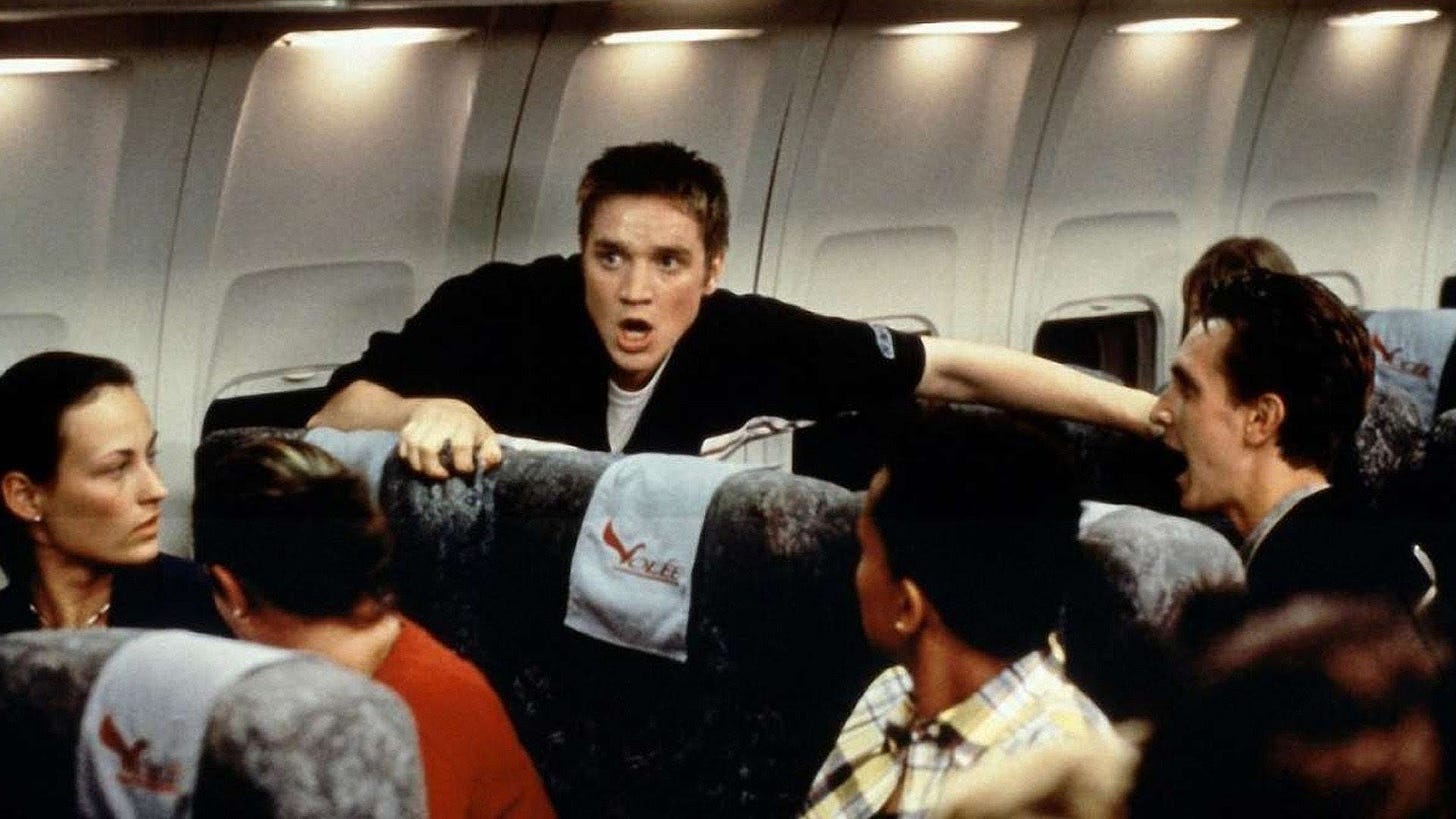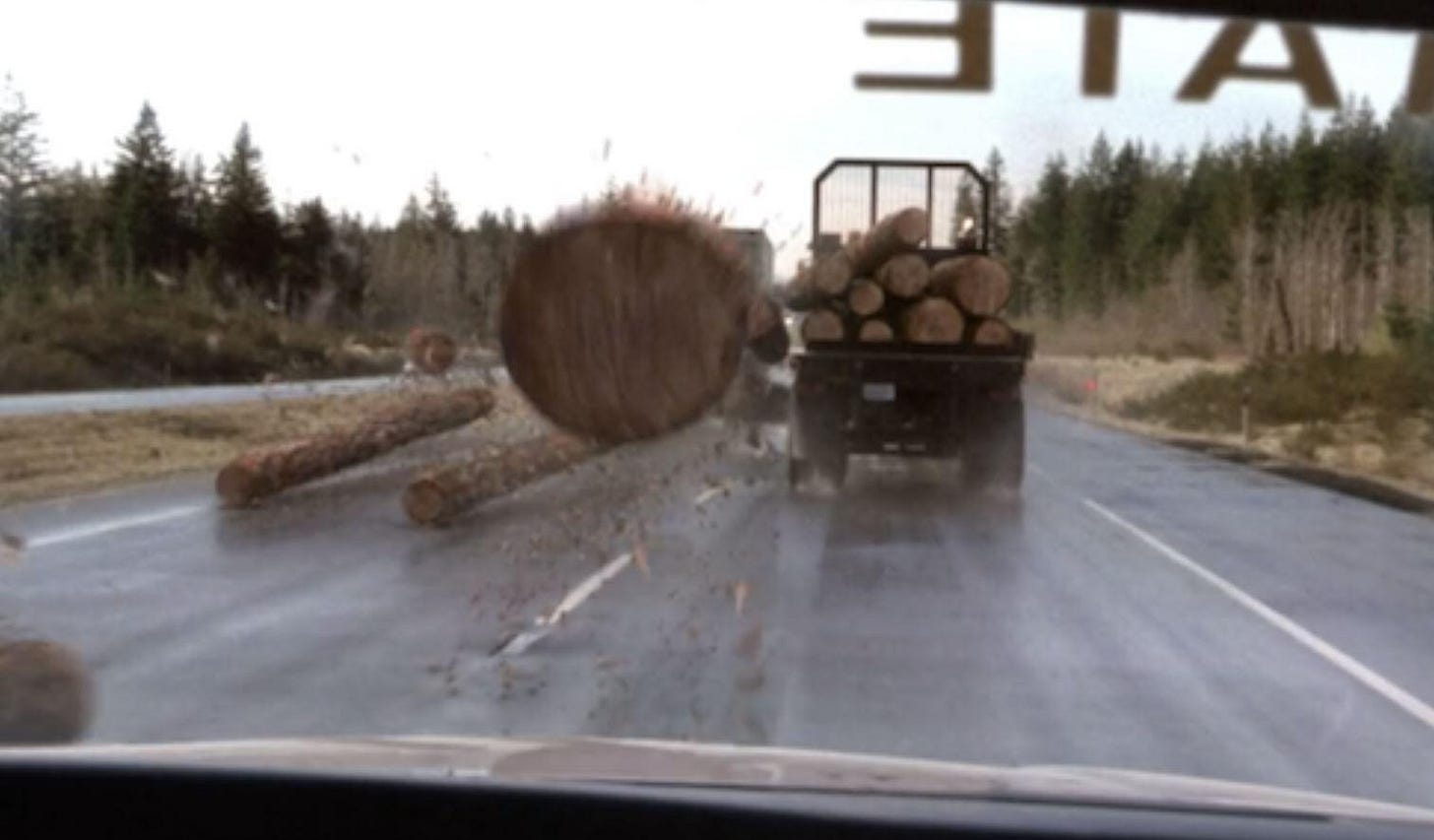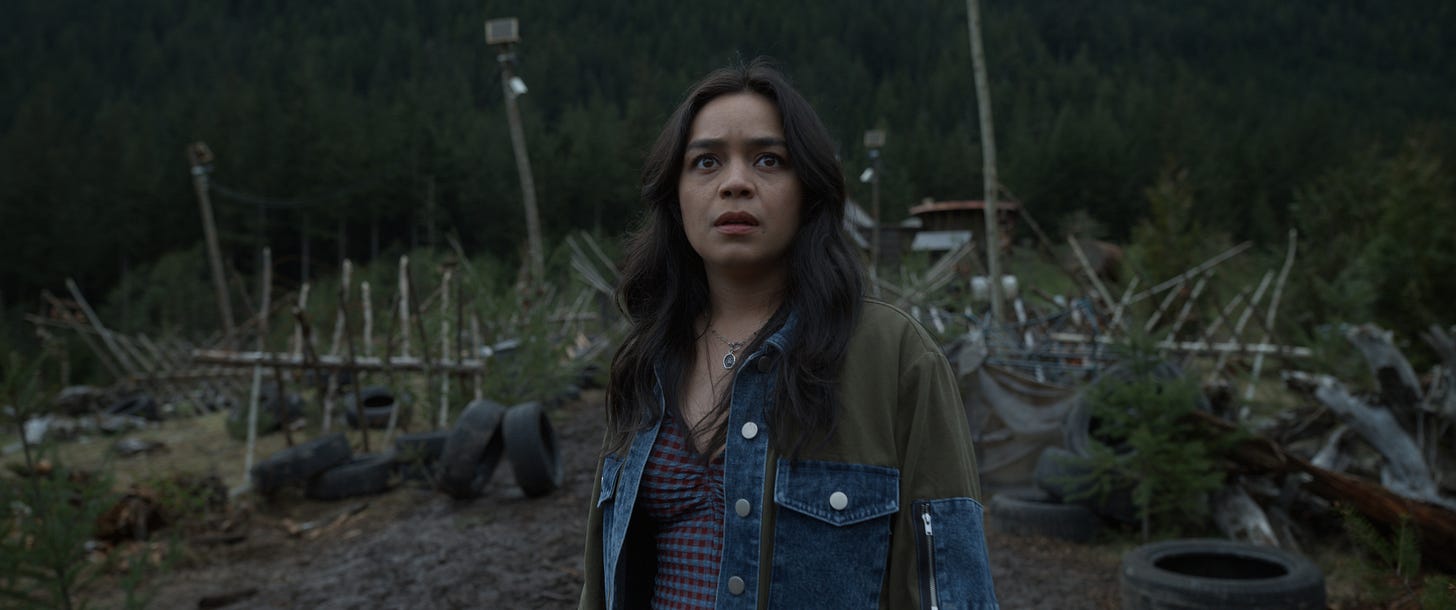Oops!…I Dead It Again
From Shakespeare to Final Destination: Bloodlines via the apocalypse not now of Threads, disaster is deliriously enticing
Death has been on my mind a lot recently. It’s been a year since the earth cracked and cinematic galaxy brain Lee Gambin, a tireless champion of film and theatre, slipped through, taking his chaotic good energy with him and leaving this mortal coil all too quiet.
Then there’s the small matter of a world on fire. Of Israel’s morally repugnant assault on Gaza and the West Bank, as craven world leaders watch on in complicit silence or active support of genocidal war crimes, and newspaper editors belatedly pretend they were always against the bleeding obvious.
Rather than retreat into happier places, I’ve been oddly hoovering up worst-case scenarios, like the battle cry of Shakespeare’s grim conclusion to the Henriad, Henry V Henry V. Staged at Arts Centre Melbourne by Bell Shakespeare, as directed by Marion Potts, this startling production – styled Henry 5 – delivers a gut punch in a boxing gym.
Well worth heading once more unto the breach for, Henry 5 whirls disorientatingly around the gore-soaked dirt of Agincourt (I hope no one was injured slipping in the show’s viscerally realised muck during the run). While newcomer JK Kazzi isn’t quite ready for the title role, swallowing the Bard’s lines and lacking the king’s newfound (at Falstaff’s expense) gravitas, this staging welcomely plays down the grasping monarch’s pompous patriotism. The chest-beating foregrounded in Laurence Olivier’s 1944 big screen adaptation is very much a pomp and ceremony propaganda piece, given the hour.
Instead, this boxing ring-styled court and its players, clad in military-inspired gym gear ingeniously crafted by set and costume designer Anna Tregloan, magnifies the madness of war. Of slaughter paid for in the broken bones and blood of the poor, not quite satiating the vaulting ambitions of the annex-happy rich.
Casting French-speaking actors, deploying that beauteous language silkily with the aid of surtitles, is a stroke of genius that allows for a more balanced view of the court of King Charles VI (a magnificently withering Jo Turner) and the impatient Dauphin (Jack Halabi). Intractable sides ablaze with fury, but also grave misgivings, lend greater tragedy to the desperate parlay of their herald (Mararo Wangai). When the war is ‘won’, the coercive bartering away of hard-done-by Princess Katharine (Ava Maddon) is equally grim.
Ella Prince’s dignified Exeter, navigating disaster as best they can, has all the hallmarks of a once and future king; Bell Shakespeare take note. Emerging actor Harrison Mills, with his swagger, reveals a star in the making and Alex Kirwan, adopting the opening monologue’s prologue, also shows promise.
With the silenced dead piled high on either ‘side’, Henry 5, it’s galling that the king would think a commoner he briefly dallied with in disguise would welcome the slaughter he unleashes when all is said and done. Already brutal after we’ve witnessed the boyish misbehaviour of Hal and his abandonment of wayward days-leading Falstaff in previous plays, Henry V leaves us certain the king’s victory is, like his crown, hollow.
It is very much a play for our days.
Pulled apart
Armageddon was on my mind, too, during a renewed pull at Threads. A staggering telemovie first glimpsed in my youth, it scarred me forevermore with the nagging suspicion that our maddening desire to undo everything is predestined: a scorched earth policy scored into our collective prefrontal cortex.
And despite it giving me the willies, so much so that I was sure the Gulf War would be it, I keep returning to it, perhaps because, unlike those whose response to genocide is to perpetrate another, I truly believe we must not just face our demons, but cast them out.
What’s new to me is the realisation that director Mick Jackson’s 1984 (how appropriate) nightmare, written by Barry Hines (who co-adapted his novel Kes for the Ken Loach movie), was an Australian co-pro between the BBC and the Nine Network. There’s no real hint, contained therein, of whether the great southern land could withstand the darkened skies of nuclear winter, a toxic swirling stretching out insidiously from the northern hemisphere.
Or would we wait to die slowly – a la Nevil Shute’s novel On the Beach, famously bringing Hollywood to Frankston via Stanley Kramer’s film featuring Ava Gardner, Gregory Peck, Fred Astaire and Anthony Perkins – or fast and furious, like We Bury the Dead director Zak Hilditch’s These Final Hours?
An immaculate sense of the bigger global picture is embedded in this cautionary klaxon purportedly heard by an otherwise hawkish Reagan. Opening with the misleading lull of cosy kitchen sink drama, a la Coronation Street, this Sheffield-set tempest begins softly softly. Ruth (Karen Meagher, who would also appear in Chernobyl: The Final Warning) and Jimmy (future Corrie star Reece Dinsdale) are young lovers whose unexpected pregnancy, thankfully, is no big deal for their families. But from the opening shot of their car parked unnervingly close to the edge of Curbar Edge’s uncanny gritstone escarpment, there’s a spine-tingling fear of impending collapse.
A downfall grasped in bits and bobs as a mum knits in front of the telly, of newsflashes that are all but drowned out down the local pub but eventually spark a lockdown-recalling riot of panic buying in a jacked-up prices supermarket when the radio ultimately announces war.
We glean, piece-by-piece, that the Soviet Union has seized a remote military installation in Iran, suspecting the US of fomenting a coup there. With skirmishes between the superpowers escalating inexorably, what begins with limited use of tactical nukes soon devolves into an all-out apocalypse. One that erupts directly over Sheffield because of its proximity to RAF Finningley Airbase. As an aside, no doubt my beloved hometown of Glasgow would be annihilated, parked as it is unwillingly close to the UK’s submarine-bound nuclear arsenal at Faslane. Don’t get me started on that front…
“Our lives are woven together in a fabric. But the connections that make society strong also make it vulnerable.”
So goes the opening narration in a hybrid film that never pierces our bubble of belief despite these occasional RP-style documentary interjections and on-screen fact scrolling. If anything, the factual veneer only serves to toughen the played very straight drama below, an all-too-real timeline of disaster that hits harder still because the nuclear strikes that tear Ruth, Jimmy, their families and millions of civilians the length and breadth of Britain are only the beginning.
The greatest takeaway? You’re best dying in the initial strike, because what follows is grim as all hell, from the initial effects of radiation poisoning mimicking those of a well-deserved panic attack, through agonising convulsions and on. Survivors would have to pick through a shattered world littered with the rotting dead. Electricity, phone lines and the internet would be gone. Order would collapse as rapidly as roads and buildings, as nuclear night starves the crops and water comes bearing dysentery and cholera and madness awaits in ways that make the wastelands of the Mad Max movies look civilised.
Threads is as much vital viewing now as it ever was and should be mandatory for all putrid politicians whose Henry-like ambitions frame people as naught but pawns in their paltry of spirit power plays.
Death comes for us all
NOTE: spoilers ahead for legacy Final Destination films
Let us turn from the monstrosity of avoidable war to the gleeful embrace of death’s chilling games in Final Destination: Bloodlines. One of few horror franchises to have continually underlined the inescapability of the Grim Reaper’s design, even final girls’ guts are gouged by its cruel talons, with successive sequels/prequels gladly managing to avoid anthropomorphising the beast.
Before embarking on Bloodlines, both prequel and sequel, I committed to watching all its forebears’ bar one, with four near universally maligned and unavailable on Max. Diving back in, I welcomed the shiver of an unsettling rustle of wind and the darkening skies that announce awaiting mayhem.
I’m often mocked for favouring Return of the Jedi over Empire Strikes Back (justice for the Ewoks) but, on-brand with this post, both deal in the darkest days of war in ways perfected by Tony Gilroy’s Andor. On that note, it’s received knowledge that the first Final Destination sequel surpasses the original, largely due to the brain-splattering boring of bombs-away logs unleashed in its monumental highway pile-up opening sequence. And it is magnificent, abiding by the more-is-more rule of follow-ups. It also hoodwinks us into a false sense of security that death can be cheated via the self-checked-in padded cellmate of Ali Larter’s returning Clear Rivers.
Sassy and supposedly all-knowing about the rules of horror movies and their sequels, Clear remains the only character to step confidently from one film to another, bearing the morosely wise misgivings of the late, great Tony Todd’s sorely missed mortician, William Bloodworth, who notably sat out Final Destination 4. Though technically Alex survives the first film, too, he’s mercilessly offed by a falling brick offscreen, announced by Clear in a throwaway line.
Clear’s ‘survival’ is the greatest bait and switch, setting her up as the final girl throughline only to barbecue her with hospital oxygen canisters ignited by a sparking plug (death sure does love electricity and/or fuel-related slayings) in much the same way as Kennedy’s dearly departed Randy Meeks in Scream 2. Death had other ideas.
For me, the original best withstands the test of time. It’s rawer, spookier and less overtly pleased with itself. Maybe it’s because I’m not a driver, and I fly a few times a year – does one outweigh the other in the ‘we’re fucked’ carbon count? – but that terrifying plane conflagration is unsurpassable, particularly when we get to see Volée Airlines Flight 180 go ka-boom again. Director James Wong glories in Final Destination’s portentous vision – gifted to a cursed Alex Browning (Devon Sawa) – allowing us a window-shattering grounded perspective from their JFK lounge.
Chad Donella’s death remains the most genuinely upsetting, partly because of its uncanny timing as the teens wrestle with survival guilt at a memorial service, but also because Tod’s fate, heightened as it is, is still one of the series’ most believable and unfortunately drawn-out deaths, garrotted by a bathroom clothesline as his feet fail to find purchase in a slippery bath.
When Terry (Amanda Detmer) meets a speeding bus with impeccable comic timing, it’s the perfect guffaw-inducing template for all that comes in the series after an electrified hills hoist tornado finale through the don’t go to Paris sting that almost wraps it all up. I also love the low-key FBI plotline that only pops up once more, despite the fact the series’ bizarro deaths should be ringing all sorts of official alarm bells.
From there to director David R. Ellis sterling sequel – sadly, he also helmed 4 – and after that truck stop driving behind of doom, there’s much glee to be mined in an errant fire escape ladder saving its impaling of dudebro Evan (David Paetkau) until after a flaming microwave fire and garbage disposal mincer near escape. “Jesus Christ,” will not save him.
The plummeting pane of glass taking its sweet time via Daphne du Maurier-approved dive-bombing pigeons and a frankly surreal dental check-up gone wrong but averted is another all-time (laughing gas) high. The elevator scene works wonders despite being arguably the most over-egged of all – come on with the claw-handed mannequins guy – with two delivering one of the most low-key finales.
Other faves across the first run include the absolute scenes of Wong’s Final Destination 3 opener set on a wonky rollercoaster, hardwired into my impressionably young mind thanks to James Goldstone’s 1977 film of the same name. This one’s a little sluggish, otherwise, with Mary Elizabeth Winstead’s Wendy doing my head in a bit. In a series that delights in silliness, she’s just too much, between drawing her risible long bow connecting their fates to Abraham Lincoln and 9/11, through to her monumentally slow failure to warn work-out bro Lewis (brilliantly named Texas Battle) in a timely fashion, stretching credulity way past breaking point’s internal logic.
A big yes to the 3D bridge collapse and boat mast impaling of Steven Quale-helmed Final Destination 5, the agonisingly prolonged gymnasium jelly bones moment, the dark me-too comeuppance of sleaze-avenging acupuncture with Buddha’s approval, Dario Argento-operatic laser surgery and the sublime time loop that takes us back to where we started.
There will be blood
Where do you begin to pick things up again over 15 years later? It’s a question answered with reverence and fully fiendish joy by Final Destination: Bloodlines.
Directed by Freaks helmers Zach Lipovsky and Adam B. Stein from a screenplay by Lori Evans Taylor, Jon Watts and Scream re-booter Guy Busick, it opens on the inaugural day of an ill-fated viewing tower restaurant in the ’60s. Gleaming with world of tomorrow promise, it’s nevertheless cursed with a wonky lift, creaking support beams and a bitch of a kid with a penny to spend over the edge, assuring us all is not well from the off.
Sadly for Iris (Brec Bassinger), her loved-up beau Paul (Max Lloyd-Jones) has brought her here to propose, just as she realises and reveals she is pregnant. Moments later, that portentous penny is sucked into an air vent in tandem with a crystalline chandelier spear striking a glass dancefloor that’s nowhere near strong enough to contend with a doo-whopping crowd shaking it to a band. These harbingers set in motion one of the franchise’s most epic disaster movie sequences. Turns out the opening day celebrations crash into closing night, but not before everything from a grand piano to a flambee desert get their shot at striking down a lot of peeps.
Iris survives, using her premonition to save as many souls as possible. Therein lies the ingenuity of this reboot. We can conjecture that everyone from the previous films was actually a descendant of this disaster’s survivors, forcing death to work overtime for decades to catch up and allowing many of the marked to start their own families, tracing bloodlines further than ever before. It also works in a teary tribute to Todd, who bows out here with a beautiful knowing wink to the audience in a role that remains remarkably under-explained, as it should be. Would that more horror sequels honour their inherent mysteries.
There’s a nice twist on intergenerational trauma when we then jump to now and a grizzled Iris (Gabrielle Rose) has Clear-like retreated, not to a padded-wall institution but instead a remote fortified cabin (ok, this is a bit Blumhouse Halloween reboot with Jamie Lee Curtis’ Laurie). But when Iris’ estranged granddaughter Stefani (Kaitlyn Santa Juana) starts losing sleep over visions of that ordeal way back when, she seeks her gran’s help despite the misgivings of her extended family.
Not that they’ll be extended much longer as another manically macabre murderfest ensues. I won’t spoil any of the gloriously gory details, but suffice it to say that I’m glad I got at least one of several MRI scans – there are nuisance but non-fatal reasons why it’s been a while between posts – out of the way before seeing a magnificently prolonged hospital sequence that perfects Final Destinations’ unholy art of the tease, those that remain will be a touch more tense. Fair play, I did crack a cackle when Final Destination 3’s classic twin tanning bed torching of Ashley and Ashlyn (Chelan Simmons and Crystal Lowe) popped into my twisted brain as the MRI minded my insides.
Ultimately, Final Destination is all about catharsis, staring death in the eye and spitting on our grave. That’s as priceless as a demonic penny in a world so intent on destroying itself that we need gallows humour to hoist our spirits up. May their chaos live forever.
Elsewhere
I chatted to Murderbot star Alexander Skarsgård and the showrunners for the ABC, plus chats with Andres Veiel, director of stunning doco Riefenstahl, and Levan Akin, helmer of the luminous Crossing.
An interview with Sherlock & Daughter creator Brendan Foley for SBS.
My review of Nic Cage’s latest (sort of) freak out, The Surfer, for ScreenHub, plus my take on The Handmaid’s Tale’s final run and National Theatre Live’s Dr Strangelove.
I chatted to The Narrow Road to the Deep North director Justin Kurzel for The Saturday Paper and reviewed the show here.
A triptych of theatre reviews over at Time Out, in the underworld mining Hadestown and Beetlejuice, plus a one-woman spin on Daphne du Maurier’s The Birds.
Plus some ideas for Sydney Film Festival selections here and here.










